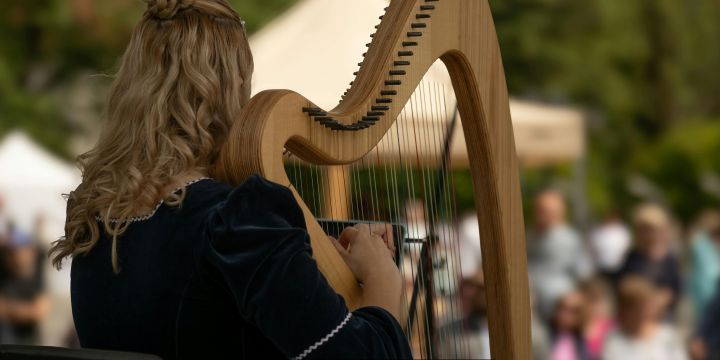Slipping tuning pins present a significant challenge for harpists, affecting both the instrument’s performance and the musician’s experience. Tuning pins are essential components of a harp, responsible for holding the strings in place and maintaining the correct pitch. When these pins slip, the strings can lose tension, leading to a flat or out-of-tune instrument.
This issue can be particularly frustrating for performers, as it disrupts the flow of practice and performance, making it difficult to achieve the desired sound quality. The phenomenon of slipping tuning pins is not merely an inconvenience; it can also indicate underlying issues with the harp itself. Factors such as humidity, temperature fluctuations, and the age of the instrument can all contribute to this problem.
Understanding the mechanics behind tuning pins and their role in sound production is crucial for harpists who wish to maintain their instruments effectively. By recognizing the signs of slipping tuning pins early on, musicians can take proactive measures to address the issue before it escalates.
Key Takeaways
- Slipping tuning pins can cause a harp to go out of tune frequently, affecting the overall performance and sound quality.
- Causes of slipping tuning pins include changes in humidity, worn out or improperly fitted tuning pins, and poor maintenance.
- Slipping tuning pins can lead to a decrease in the harp’s resonance, pitch stability, and overall playability.
- Preventing slipping tuning pins involves regular maintenance, proper installation, and using humidity control devices.
- DIY solutions for addressing slipping tuning pins include using rosin, chalk, or pliers to tighten the tuning pins, but seeking professional help is recommended for a long-term fix.
- Seeking professional help for slipping tuning pins is crucial for identifying the root cause and implementing a lasting solution.
- Replacing tuning pins may be necessary if they are worn out or improperly fitted, and it should be done by a qualified technician.
- Maintaining tuning pins for long-term stability involves regular inspections, proper installation, and addressing any issues promptly to prevent slipping.
Causes of slipping tuning pins
Several factors can lead to slipping tuning pins, each contributing to the overall instability of the harp’s tuning system. One primary cause is the wear and tear that occurs over time. As a harp ages, the wood and metal components can undergo changes that affect their ability to hold tension.
The tuning pins themselves may become worn or lose their grip within the pinblock, leading to slippage. This is particularly common in older harps that have been played extensively. Environmental conditions also play a significant role in the stability of tuning pins.
Humidity and temperature fluctuations can cause the wood of the harp to expand and contract, affecting the fit of the tuning pins in their respective holes. High humidity can lead to swelling, while dry conditions can cause shrinkage, both of which can compromise the pin’s ability to stay securely in place. Additionally, improper string tension can exacerbate these issues, as strings that are too tight or too loose can place undue stress on the tuning pins.
Effects of slipping tuning pins on harp performance
The effects of slipping tuning pins on harp performance can be profound and far-reaching. When tuning pins slip, the strings lose their tension, resulting in a noticeable drop in pitch. This can create a dissonant sound that is not only unpleasant but also distracting for both the performer and the audience.
For professional harpists, maintaining perfect pitch is essential, as even slight deviations can impact the overall quality of a performance. Moreover, slipping tuning pins can lead to increased frustration during practice sessions. Musicians may find themselves constantly retuning their instruments, which can disrupt their focus and hinder their progress.
This constant battle with tuning instability can also lead to a lack of confidence in one’s instrument, making it difficult for harpists to fully express themselves musically. In ensemble settings, slipping tuning pins can create discord among musicians, as an out-of-tune harp can clash with other instruments, detracting from the overall harmony of a performance.
Preventing slipping tuning pins
| Preventing Slipping Tuning Pins | Metrics |
|---|---|
| Frequency of tuning pin slippage | Monthly |
| Number of tuning pins replaced due to slippage | Quarterly |
| Effectiveness of current pin treatment methods | Annually |
Preventing slipping tuning pins requires a combination of regular maintenance and attention to environmental factors. One effective strategy is to ensure that the harp is kept in a stable environment with controlled humidity and temperature levels. Using a hygrometer can help monitor these conditions, allowing harpists to make adjustments as needed.
Additionally, placing a humidifier or dehumidifier near the instrument can help maintain optimal conditions, reducing the risk of wood expansion or contraction that could lead to slippage. Regular maintenance of the tuning pins themselves is also crucial for prevention. Harpists should periodically check the tightness of each pin and ensure that they are properly seated in their holes.
If any pins feel loose or are slipping frequently, it may be beneficial to apply a small amount of graphite or lubricant specifically designed for tuning pins. This can help improve grip and reduce friction, ultimately enhancing stability. By taking these proactive measures, harpists can significantly reduce the likelihood of encountering slipping tuning pins.
Addressing slipping tuning pins: DIY solutions
For those who encounter slipping tuning pins, there are several DIY solutions that can be employed before seeking professional assistance. One common method involves tightening the tuning pin itself using a specialized tuning pin wrench. This tool allows musicians to apply additional torque to the pin, ensuring that it is securely fastened within its hole.
However, care must be taken not to overtighten, as this could lead to damage or further complications. Another DIY approach involves using a mixture of wood glue and sawdust to create a paste that can be applied to loose tuning pin holes. This paste fills any gaps between the pin and its hole, providing additional grip and stability.
Once applied, it is essential to allow sufficient time for the glue to dry before retuning the strings. While these solutions may not be permanent fixes, they can provide temporary relief from slipping tuning pins until more comprehensive repairs can be made.
Seeking professional help for slipping tuning pins
While DIY solutions can be effective in addressing slipping tuning pins, there are instances when seeking professional help is necessary. Experienced harp technicians possess specialized knowledge and tools that allow them to diagnose and resolve issues more effectively than most musicians could on their own. A professional technician can assess the condition of the tuning pins and pinblock, identifying any underlying problems that may not be immediately apparent.
In addition to fixing slipping tuning pins, a professional technician can provide valuable insights into overall harp maintenance and care. They may recommend adjustments or repairs that could enhance the instrument’s performance and longevity. For harpists who rely on their instruments for professional performances or recordings, investing in expert assistance is often well worth it, ensuring that their harps remain in optimal playing condition.
Replacing tuning pins
In some cases, replacing slipping tuning pins may be necessary to restore stability and performance quality. Over time, tuning pins can become worn or damaged beyond repair, necessitating their replacement with new ones. This process typically involves removing the old pins carefully and installing new ones that fit securely within the pinblock.
It is essential for this task to be performed by a skilled technician who understands the intricacies of harp construction. When replacing tuning pins, it is crucial to select high-quality materials that are compatible with the specific harp model. The choice of metal used for new tuning pins can significantly impact their durability and performance.
Additionally, ensuring that the new pins are properly seated and aligned will help prevent future slippage issues. By investing in quality replacements and professional installation, harpists can enjoy improved stability and sound quality for years to come.
Maintaining tuning pins for long-term stability
Long-term stability of tuning pins requires ongoing maintenance and attention from harpists. Regularly checking the tightness of each pin should become part of a musician’s routine care regimen. This practice not only helps identify potential issues early but also reinforces good habits that contribute to overall instrument health.
Furthermore, maintaining consistent environmental conditions is vital for preserving both the wood and metal components of the harp. Harpists should strive to keep their instruments away from direct sunlight, heat sources, and areas with high humidity fluctuations. By creating a stable environment and practicing regular maintenance routines, musicians can significantly extend the life of their tuning pins and ensure that their harps remain reliable companions throughout their musical journeys.
In conclusion, slipping tuning pins pose a challenge for harpists that requires understanding, prevention strategies, and maintenance practices. By recognizing the causes and effects of this issue, musicians can take proactive steps to address it effectively. Whether through DIY solutions or professional assistance, maintaining stable tuning pins is essential for achieving optimal performance and enjoying a fulfilling musical experience with this beautiful instrument.
If you are a harp player experiencing issues with slipping tuning pins, you may find this article on unpacking the effects and uses of HHC vs THC to be an interesting read. Understanding the differences between various types of THC can help you make informed decisions about the products you use to maintain your instrument.
FAQs
What is a tuning pin on a harp?
A tuning pin is a small metal pin that is used to adjust the tension of the strings on a harp, thereby changing the pitch of the notes produced.
Why does a tuning pin on a harp slip?
Tuning pins on a harp can slip due to a variety of reasons, including changes in temperature and humidity, wear and tear on the harp, or improper installation of the strings.
How can I prevent tuning pins from slipping on my harp?
To prevent tuning pins from slipping on a harp, it is important to keep the harp in a stable environment with consistent temperature and humidity levels. Regular maintenance and proper installation of the strings can also help prevent tuning pin slippage.
What should I do if a tuning pin on my harp slips?
If a tuning pin on your harp slips, it is important to address the issue promptly to avoid further damage to the instrument. This may involve tightening the pin, replacing the string, or seeking professional assistance from a harp technician.




